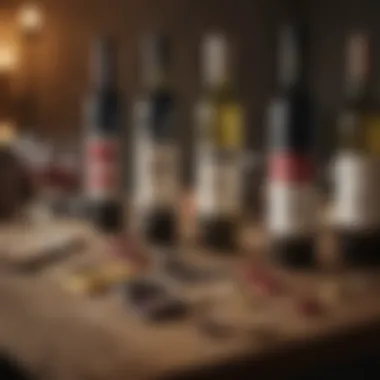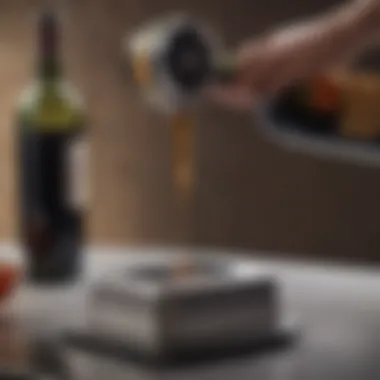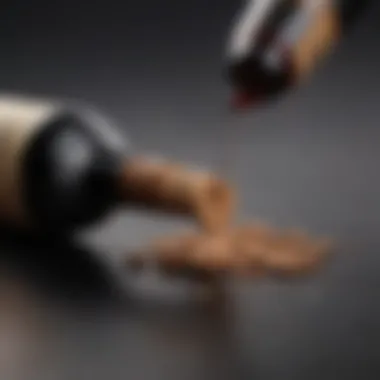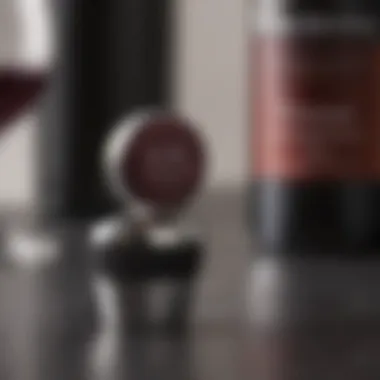The Importance of Wine Sealers for Quality Preservation


Intro
Wine sealers serve a critical function in the worlds of oenology and wine appreciation. Many people open a good bottle of wine and do not finish it in one sitting. Preserving the quality of the remaining wine is essential for curating an enjoyable experience. Wine sealers can help achieve this. Understanding the different types of wine sealers available and their respective functionalities will aid wine lovers in making informed choices. This discussion will cover the significance of wine sealers, the materials used, and considerations when selecting the right sealer.
Types of Wine Sealers
There are various wine sealers on the market, each serving different functions. Here we outline some of the most common types:
- Cork Stoppers: The classic choice for wine bottles, corks can be reused, though they often lose their effectiveness after a few uses. Traditional cork allows some air to interact with the wine, which can sometimes be beneficial for aging.
- Vacuum Pump Sealers: These devices remove air from the bottle once opened, limiting oxidation. The removal of air is essential, as it slows down the wine's degradation. Vacuum pump sealers typically come with rubber stoppers specifically designed to create a strong seal.
- Wine Sprayers: A lesser-known but innovative option, these devices spray a thin layer of inert gas (like argon) into the bottle, which then floats above the wine. This technique helps reduce oxidation by minimizing contact with oxygen.
- Screw Caps: Popular in many regions, screw caps offer a superior seal compared to corks. They eliminate the risk of cork taint and allow for easy reopening without the need for tools.
Why Wine Sealers Matter
The importance of wine sealers lies in their ability to maintain the integrity of the wine. Once opened, exposure to oxygen begins to affect the wine's flavor profile. Here are key reasons why sealers are crucial:
- Preservation of Flavors: Wine sealers keep the delicate balance of flavors intact. Each type of wine possesses unique characteristics that can be altered, sometimes irreparably, by unwanted oxygen exposure.
- Maintaining Aroma: Aromas can dissipate quickly after a bottle is opened. A proper seal helps preserve the fragrant bouquet that wine lovers cherish.
- Preventing Spoilage: Some wines are more prone to spoilage than others. For instance, lighter wines, like whites and rosés, tend to degrade faster than bold reds. Sealers can help extend their drinking window.
- Economic Consideration: Wine can be a significant investment. Proper selection of a wine sealer allows individuals to enjoy a portion of the bottle now and save the rest for future tastings, saving money over time.
"Proper preservation of an opened wine bottle is not just about taste, but also about the overall experience."
Considerations When Choosing a Wine Sealer
When selecting a wine sealer, there are several factors to consider:
- Type of Wine: Different wines have varying needs for preservation. For example, a full-bodied red may benefit from a different sealer than a delicate white.
- Ease of Use: Some sealers require more effort than others. Vacuum pumps require additional steps, while screw caps are straightforward and quick.
- Storage Conditions: Where the wine is stored after opening can affect the longevity. A cooler, dark place is ideal.
Understanding these details empowers wine enthusiasts to preserve their wines effectively and appreciate their investment. Each wine sealer has its merits and potential drawbacks. Tailoring the choice to specific wine types and preferences ensures a more enjoyable experience.
Understanding Wine Sealers
The role of wine sealers is crucial for anyone who values the quality and longevity of their wine. Understanding the functionality of these sealers gives insight into how they maintain the flavors and aromas that are intrinsic to each bottle. The process of sealing wine extends beyond merely corking a bottle; it involves selecting the right material, addressing exposure to air, and considering the effects on taste over time.
Wine sealers protect the drink from oxidation and contamination, which can significantly alter its intended profile. As such, wine lovers must appreciate the various types of sealers available and their respective advantages and disadvantages.
Definition and Purpose
Wine sealers are devices or materials used to close wine bottles tightly after they have been opened. Their main purpose is to preserve the quality of the wine by limiting its exposure to air. When oxygen interacts with the wine, it can lead to oxidation, resulting in off-flavors and a loss of freshness. Therefore, choosing the right wine sealer is essential for maintaining the intended taste and aroma.
Depending on the type of sealer used, the preservation method can vary. For instance, traditional corks allow limited air exchange, while vacuum sealers remove air from the bottle entirely. This significantly impacts how long a wine retains its original characteristics. The primary objective is to prolong the wine's life and ensure it tastes as intended when consumed.
Historical Perspective
Historically, the method of sealing wine has undergone significant evolution. The use of cork has been prevalent since the 17th century. Originally, winemakers used cork from tree bark because of its ability to expand when wet, creating a tight seal against oxygen. This method was deemed effective for many years.
However, as wine consumption and production expanded globally, issues like cork taint emerged, prompting the exploration of alternatives. Synthetic corks and screw caps began appearing in the 20th century, offering solutions that addressed some inherent flaws of traditional corks.
These developments reflect broader trends in wine production and consumption. Each type of sealer has its advocates and opponents, leading to ongoing debates about the best methods for wine preservation. Understanding this historical context is beneficial for appreciating current practices and for making informed choices about wine sealers.
Types of Wine Sealers
Understanding the various types of wine sealers is crucial to maintaining the quality and taste of wine after opening. Each sealing method has its unique properties and effects on the wine, influencing flavor and preservation. The right choice can enhance the experience of wine lovers and ensure that each sip stays delicious.
Corks


The traditional cork has been used for centuries to seal wine bottles. It remains a prominent choice among wine producers and enthusiasts alike.
Natural Corks
Natural corks are harvested from the bark of cork oak trees. This aspect makes them a renewable resource, but their availability is limited. Natural corks provide a classic seal, allowing wines to breathe while preventing unwanted air from entering. This characteristic contributes positively to the aging process of many wines. However, a downside is the risk of cork taint, which can spoil the wine’s flavor. Their popularity is mainly because they preserve the wine’s integrity and maintain optimal conditions until consumption.
Composite Corks
Composite corks are made from small pieces of natural cork combined with synthetic materials. They aim to offer an economical and consistent alternative to natural corks. Their key benefit is that they reduce the likelihood of cork taint, which can affect the wine’s taste. Additionally, composite corks allow for good preservation but do not have the same aging potential as natural corks. Their uniformity in production makes them a practical choice for many producers, particularly in bulk wine.
Synthetic Corks
Synthetic corks have gained traction as an alternative to traditional cork materials. Made from plastics, they are entirely impermeable, preventing any air exposure. Their primary advantage is consistency; they do not suffer from cork taint, ensuring a pure drinking experience. However, some wine purists argue that synthetic corks do not allow the wine to breathe sufficiently, which can limit the wine’s ability to develop characteristics over time. As a result, synthetic corks are often employed in lower-priced wines where immediate consumption is expected.
Screw Caps
Screw caps are becoming increasingly favorable in the wine industry. They provide an airtight seal, which protects wine from oxygen. This method reduces the risks associated with corks, such as cork taint and inconsistent aging. Many producers see screw caps as a modern approach, considering them user-friendly and reliable for maintaining freshness. Furthermore, they are widely viewed as a way to ensure quality in white wines and others meant for early consumption.
Wine Pump and Vacuum Sealers
Wine pumps and vacuum sealers introduce an innovative approach to sealing bottles post-opening. The key aspect of these devices is their ability to remove air from the bottle, which helps to slow down the oxidation process. By creating a vacuum seal, these systems greatly enhance the wine’s lifespan. They cater to the needs of wine drinkers who wish to enjoy their bottle over time without compromising flavor. However, using these devices requires additional effort compared to traditional sealing methods.
Pressure Sealers
Pressure sealers have also emerged as a viable option for preserving wine freshness. They work by applying a controlled amount of pressure to the bottle, effectively reducing air exposure. This sealing method is becoming more popular for wines that benefit from longer storage. The main advantage lies in maintaining the wine's bouquet and flavor profile, preventing degradation. However, they may not be suitable for all types of wines, limiting their usage in the overall market.
Mechanism of Action
Understanding the mechanism of action of wine sealers is crucial to appreciating their role in preserving wine quality. Wine sealers not only seal the bottle but also manage how external elements influence the wine inside. This section delves into how these devices maintain wine integrity and the specific ways they control oxygen exposure.
How Sealers Maintain Integrity
Wine sealers serve a pivotal function in maintaining the integrity of wine after it has been opened. Good sealers create an effective barrier that prevents external elements from entering the bottle. This barrier helps in preserving the original taste and aroma of the wine.
Several factors come into play when discussing how sealers achieve this:
- Material Selection: The choice of material significantly affects the sealing capability. For instance, natural corks allow some micro-oxygenation, which can enhance certain wines over time. In contrast, synthetic corks and screw caps offer a more airtight seal, which can be ideal for wines that do not benefit from this process.
- Seal Fit: The physical fit of the sealer is equally important. A perfect seal, especially with screw caps, means there is minimal air exchange. This feature can be crucial in prolonging the life span of the wine.
- Durability: A durable sealer will withstand pressure changes and temperature fluctuations, which further helps preserve the wine.
Each type of sealer, whether it is a cork, screw cap, or vacuum system, has unique attributes that influence its effectiveness in maintaining the wine's original integrity.
Impact on Oxygen Exposure
Oxygen exposure is perhaps the most critical aspect of wine preservation. Wine is a living product and begins to change when the bottle is opened. The way a wine sealer interacts with oxygen can have profound effects on flavor and quality over time.
- Controlled Exposure: Some sealers are designed to limit oxygen exposure. For instance, vacuum sealers actively remove air from the bottle, slowing the oxidation process, which can benefit certain wines, particularly lighter and more delicate varietals.
- Micro-oxygenation vs. Excess Oxygen: Natural corks allow for small amounts of oxygen to permeate, which can enhance aging for some wines, but too much exposure can lead to spoilage. Therefore, understanding the balance is key:
- Good Micro-oxygenation enhances complexity and develops flavor over time.
- Excess oxygen can lead to vinegar-like qualities, ruining the wine's taste.
Furthermore, an effective sealer will adjust the rate of oxygen infiltration to align with the wine's aging profile.
Comparative Analysis of Wine Sealers
The comparative analysis of wine sealers is crucial for understanding their effectiveness in preserving the quality of wine after it is opened. This section will discuss the key features, benefits, and considerations associated with two commonly used types of wine sealers: corks and screw caps. Furthermore, it will evaluate the role of vacuum sealers in both short-term and long-term preservation, providing an in-depth look at how these options serve various needs for wine enthusiasts.


Corks vs. Screw Caps
Corks have been a traditional choice for sealing wine bottles for centuries. They are made from the bark of cork oak trees and are appreciated for their ability to allow a small amount of oxygen to interact with the wine. This interaction can be beneficial for the aging process of certain wines, particularly reds, as it contributes to their complex flavors. However, corks can also introduce the risk of cork taint, which affects taste negatively.
On the other hand, screw caps are a more modern sealing method. They provide a reliable barrier to oxygen, which helps preserve the freshness of the wine. Many wine producers have shifted towards using screw caps for their wines, particularly those intended for early consumption, as this method minimizes the risk of cork taint. The ease of use with screw caps also appeals to many consumers who prefer not to use corks.
Effectiveness of Vacuum Sealers
Short-term Preservation
Short-term preservation focuses on maintaining the wine's freshness and flavor after opening the bottle. Vacuum sealers play a significant role in this process. By removing the oxygen from the bottle, these devices impede the oxidation process, which can quickly affect the wine’s quality. Many users find this method beneficial because it allows them to enjoy a bottle over several days without significant degradation of taste.
The unique feature of vacuum sealing is that it prolongs the lifespan of opened wine for a few days. This method is particularly popular for individuals who enjoy a glass now and then without committing to finishing an entire bottle in one sitting. However, it may not be ideal for all wines. Some may find that wines that need oxygen for enhancement, especially complex reds, could taste flat after using a vacuum sealer.
Long-term Preservation
Long-term preservation takes a different approach, focusing on retaining the wine’s characteristics for weeks or even months. Here, vacuum sealers remain effective, but it also is essential to consider that different wines respond variably to this method. The key characteristic of long-term preservation via vacuum sealing is that it can hold a wine's original profile much longer than simply re-sealing it with a cork or screw cap.
The unique advantage here is the ability to store opened bottles for much more extended periods while minimizing the chances of spoilage. However, not every vacuum sealer is equal. Some cheaper models may not create a perfect seal, which can still allow for some level of oxygen exposure, potentially compromising the wine's quality over time.
In summary, the comparative analysis of wine sealers provides essential insights for wine lovers. Each type has its own strengths and weaknesses, and the right choice often depends on individual preferences and usage scenarios. Understanding these differences aids consumers in making informed decisions, ensuring their wine experiences remain enjoyable.
User Considerations
Understanding user considerations is essential when discussing wine sealers. The experience of enjoying wine does not end with the choice of label; it extends into how the wine is stored and preserved after opening. Wine sealers play a crucial role in ensuring that the quality and taste are maintained, reflecting the preferences and requirements of users. Factors like ease of use and cost versus benefits contribute significantly to consumer decisions.
Ease of Use
The ease of use of wine sealers greatly impacts user experience. A wine sealer should enhance the enjoyment of wine without adding complexity to the process. For instance, corks require careful handling, but they are familiar and provide a traditional feel. However, screw caps offer convenience and simplicity, allowing wine lovers to seal their bottles quickly without special tools.
Vacuum sealers demand a little more effort. Users must learn to operate the device properly, which may discourage some. Yet, those who appreciate long-term preservation find the effort worthwhile. Many modern options come with user-friendly designs that simplify the sealing process.
A hassle-free approach encourages users to incorporate sealers more regularly in their wine enjoyment. Therefore, when choosing a wine sealer, considering its user-friendliness can lead to better wine management at home.
Cost vs Benefit Analysis
When it comes to wine sealers, consumers often evaluate the cost versus the benefits. Each type of sealer comes with its own price range. Corks are generally affordable and widely available, but they may not always ensure optimal preservation.
In contrast, investing in high-quality vacuum sealers can be more expensive, but they often provide superior protection against oxidation. Consideration of long-term benefits plays a key role here. For instance, wine lovers who enjoy fine wines may find that a moderate investment in vacuum sealers yields better tasting experiences over time.
Some users might lean toward cheaper alternatives without factoring in the potential loss of wine quality. An analysis of the value derived from maintaining the wine's original taste highlights the significant benefits of investing in proper sealing methods.
Ultimately, understanding the cost versus benefits helps consumers make informed decisions, aligning their choices with both their budget and their passion for wine enjoyment.
"A well-sealed wine bottle can prolong the experience of a carefully selected vintage, making user considerations a key factor in wine enjoyment."
Taking user considerations into account ensures that wine lovers can make informed choices that enhance their overall wine experience while prioritizing quality and taste.
Environmental Concerns
The use of wine sealers has implications that extend beyond just maintaining wine quality. Understanding the environmental impacts related to various sealing mechanisms is crucial for both wine producers and consumers. Acknowledging these concerns can guide the decision-making process in selecting wine sealers that align with sustainability principles.


Sustainability of Materials
The materials used in the production of wine sealers play a significant role in their environmental footprint. Wine corks, for instance, are harvested from cork oak trees, primarily found in the Mediterranean region. Cork is a renewable resource, and harvesting it does not require cutting down the trees, which allows the ecosystem to thrive. This characteristic of corks promotes biodiversity and supports local communities who rely on cork production for their livelihoods.
In contrast, synthetic corks and screw caps are made from materials that may not possess the same sustainability profile. Synthetic corks often rely on petrochemicals, which are non-renewable and contribute to pollution. Therefore, choosing natural corks can align a wine lover's choices with more sustainable practices.
The demand for sustainable products is influencing many wine producers to adopt eco-friendly sealing options. By advancing towards greener alternatives, the wine industry not only contributes to environmental stewardship but also caters to growing consumer preferences for sustainable practices.
Recycling Options
When considering wine sealers, recycling options are an important aspect to examine. Many consumers are not aware that corks are recyclable. Numerous organizations and initiatives exist for cork recycling, allowing used corks to be repurposed for various applications including flooring materials, insulation, and crafts. This second-life potential helps minimize waste and promotes circular economy principles within the industry.
On the other hand, many screw caps and synthetic corks are not designed for easy recycling. They often end up in landfills where they may take years to break down, contributing to ongoing environmental issues. Some wineries and recycling facilities are starting programs to collect and recycle these materials, but widespread adoption is still limited.
Integrating robust recycling programs into the production and consumer use of wine sealers can significantly reduce their environmental impact. Wine producers can take initiative by creating awareness campaigns about responsible disposal practices and exploring partnerships with recycling entities.
Ultimately, both the sustainability of materials and the availability of recycling options influence the environmental considerations surrounding wine sealers. By making informed choices, consumers can help shape industry practices and impact the environment positively.
"Sustainable practices in wine sealing are not just beneficial for the environment, they also resonate with a growing base of conscious consumers seeking responsible choices."
Trends in Wine Sealing
Wine sealing technology is evolving, driven by a blend of consumer demand, innovation, and awareness about preservation. This section examines the significance of these trends in the realm of wine sealers, focusing on advancements that enhance user satisfaction and the overall wine experience.
Innovations in Design
Recent years have seen a surge in innovative designs for wine sealers. These advancements encompass materials, functionality, and aesthetic appeal. For instance, synthetic corks are being engineered to mimic the traditional cork's elasticity while offering better consistency and reliability. They are less prone to contamination, marking a hygienic advancement in wine preservation.
Screw caps have also evolved, now coming with inner linings designed to manage oxidation more effectively. Their popularity stems from their convenience and the assurance they provide against cork taint, a common issue with natural corks.
Furthermore, vacuum sealers and preservation systems are more accessible. They often incorporate smart technologies, enabling wine lovers to monitor their wine's condition using mobile applications. This integration of technology not only appeals to tech-savvy consumers but also educates them about the best practices for wine storage and serving.
Consumer Preferences
As awareness of quality preservation grows, consumer preferences have shifted toward more reliable wine sealing methods. Today's wine drinkers are more discerning, seeking assurance that their wine will maintain its integrity after opening.
In surveys, a significant number of wine consumers express a preference for screw caps over corks due to their ease of use and effectiveness in preventing oxidation. On the other hand, a subset of consumers still appreciates the tradition of cork, often viewing it as a sign of authenticity in wine.
These contrasting preferences illustrate the importance of choice in wine sealers. Wine aficionados often experiment with various sealers to determine what best suits their specific needs. Factors like convenience, preservation capabilities, and personal taste influence their decisions.
"The evolution of wine sealing technology reflects a deeper understanding of wine preservation, catering to both tradition and modern preferences."
In summary, trends in wine sealing reveal a landscape that values both innovation and consumer insight. The ongoing developments in design and the shifting preferences of consumers are making the wine experience richer, ensuring that each bottle, once opened, retains its distinct character.
Epilogue
The concluding section of this article emphasizes the essential role of wine sealers in preserving the quality and taste of opened wine. Wine enthusiasts often underestimate the impact of how a bottle is sealed after the first pour. Understanding this aspect is crucial for both casual drinkers and seasoned connoisseurs.
Final Thoughts on Wine Preservation
Wine preservation transcends mere convenience; it significantly affects the integrity of the wine itself. Selecting the right wine sealer can prolong the life of a bottle, thereby maintaining its flavors and aromas. Oxygen exposure, if not managed properly, can lead to oxidation, which alters the wine's profile, potentially ruining its character. Sealers such as vacuum pumps or quality corks serve to mitigate this risk effectively. For instance, utilizing a vacuum sealer limits oxygen interaction, often making a noticeable difference in taste when the wine is consumed days or weeks later.
Recommendations for Consumers
When choosing a wine sealer, consider the following recommendations to optimize your experience:
- Assess Your Preferences: If you enjoy specific wines, analyze which sealers best match those varietals. Some wines react better to corks, while others fare well under screw caps.
- Invest in Quality: Whether it’s a cork or a vacuum system, prioritize quality over price to ensure that your wine is being preserved effectively.
- Understand the Duration: Different sealers work optimally for various time frames. If you plan to drink within a few days, simpler solutions may suffice. For long-term storage, opt for more robust systems.
- Read Reviews: Leverage consumer reviews and expert opinions on specific products. Websites like Reddit and forums on wine allow user interactions that can guide you.
By making informed choices about wine sealers, consumers can significantly enhance their tasting experience and prolong the enjoyment of their collections.















